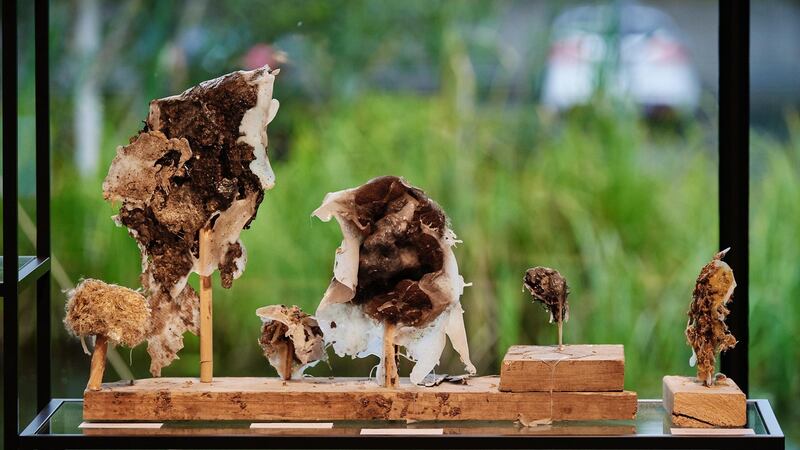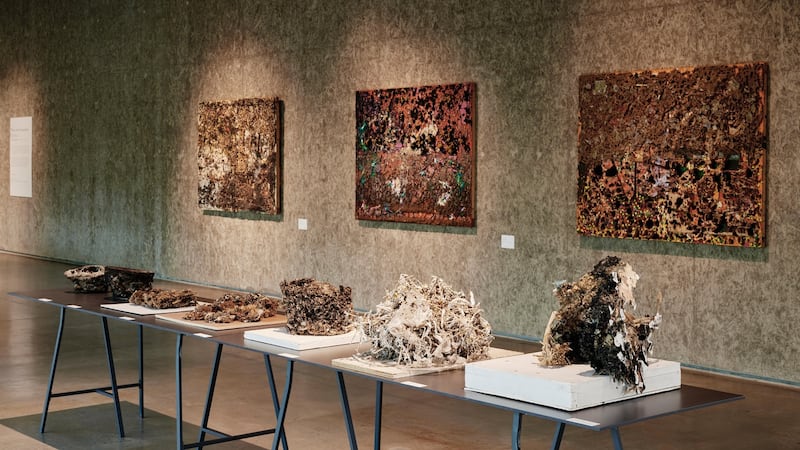Paul Mosse: What's with the Apocalypse?
Visual, Old Dublin Road, Carlow
★★★★★
Think ahead to a point in the far future. Humans are exploring other worlds. An Earth-like planet is discovered orbiting a distant star. Preliminary examination suggests the existence of an advanced civilisation, with evidence of sophisticated technology and culture. But the planet is dubbed the "Marie Celeste" because its inhabitants are nowhere to be seen. Exploratory teams are sent in. They survey what appears to be a city, identifying residential blocks, various utilities, recreational spaces and other semi-familiar features. One team arrives at what seems to be an art gallery. Its members cautiously make their way inside.

In a vast central space, they find a display of strange, sculptural objects. The objects are clearly made with extraordinary care and precision, they are complex and multi-faceted, but they are like nothing the observers have ever seen before. Are they perhaps an indication of what the planet’s inhabitants, or perhaps the deities they worship, look like?
That is pretty much the situation facing an Earth-dwelling human who visits Paul Mosse’s survey exhibition at Carlow’s Visual. We can reasonably presume most of what we see is sculpture, because after all most sculpture is three-dimensional, but it’s impossible to slot these works into any neat, familiar sculptural package. They are perplexing. They catch your eye and proceed to drag you into their own puzzling world, and into the artist’s puzzling mind. Their singular strangeness spurs an investigative curiosity about the processes that led to their creation.

What's with the Apocalypse? spans 40 years of work, and developmental arc becomes apparent. Broadly speaking, Mosse begins by dealing in terms of a rectangular, two-dimensional surface and gradually finds ways of testing the limits of a two-dimensional framework. A number of pieces, from smallish works on paper to very large "paintings" overspill the format. Then the artist breaks through the boundaries of the format completely, not just moving into three dimensions but exploding the two-dimensional surface, turning it inside out, back on itself, upside down, as though intent on reconfiguring the spatial fabric.
Mosse was born in Bennetttsbridge, Co Kilkenny. In the 1960s he studied art in Berkshire and then at Chelsea School of Art. He has remarked that colour field painting and flatness were much discussed when he was a student. But flatness was clearly never going to do it for him: “I like the notion of rods of colour coming out towards you, giving a sense of measurement in space,” he said to Sean McCrum in 1991.
By then he had made several series of impressive, well-received and relatively conventional works. They have their starting points in observations of the immediate environment: the interior of Mosse’s house and the garden outside. Rather than representing the collection of surfaces that comprised his view of the interior, or the garden, it’s as though he aims to see not just beyond the surfaces, but to encompass the complex totality of each scene.
At that stage he rendered multi-dimensionality in just two dimensions, in layers and layers of intricate patterns, Seurat’s pointillism carried simultaneously to a microscopic and macroscopic scale. These hypnotic works, several of which are included in the Visual show, evoke circuit boards, silicon chips, fiendishly complicated maps and technical diagrams, microphotographic studies of plant or animal anatomy or geological structure.
The list could go on. The sensation is akin to stepping out the door on a clear night far from the city and feeling that you are falling into the Milky Way.

As a display of materials suggests, Mosse is a close observer of the natural world, and the mundane, everyday world of wood glue and various functional synthetic materials. Examine one of his larger sculptural pieces and it’s obvious that more or less everything can be and is pressed into service. There is a curious circularity to most of the works in that each might begin with a material, typically a sheet of plywood, which is then drilled into, segmented, folded, embellished, burned and perhaps virtually eclipsed by other materials. And the sawdust, fragments, dust and whatever else is generated along the way are pressed into renewed service, joining paint, screws, plaster, polystyrene, staples, glass, wire and more, expressive of a desire to leave nothing out and throw nothing away.
The resultant works are startling, both enveloping and self-contained. Mosse sets them in motion and one senses that he doesn’t know where they will lead him, but the process is not random. He has to stay true to each piece, and the reward is that it accumulates a curious vitality as it goes along. It might sound dramatic but it’s a fair bet that, in his mind, his efforts are directed at keeping a work alive and guiding it towards independent existence. This is particularly evident when you see many works gathered in the soaring space of the main gallery: they are like creatures, with character and personality.

Mosse is not entirely removed from artistic comparisons. One that came to mind is the sculpture of Hans Josephsohn. While Josephsohn’s pieces are more representationally figurative, they are comparably disconcerting at first glance. Often they are masses, concentrated objects of uncertain nature that gradually assume the character and vulnerability and awkwardness of beings, sentient entities, humans or, let’s not discriminate here, animals.
Josephsohn (who was German by birth but became a Swiss citizen) brilliantly described his life and the nature of his work, in a way that is entirely appropriate to Mosse: “I have spent 60 years, day after day, working away calmly in my studio. I have simply followed my imagination . . . all the crises, the human ones that occur in life, and all the possible adventures and all the paths through the woods where you don’t know how you will get out again, they have all taken place in my studio.”
- Until January 12th. visualcarlow.ie











